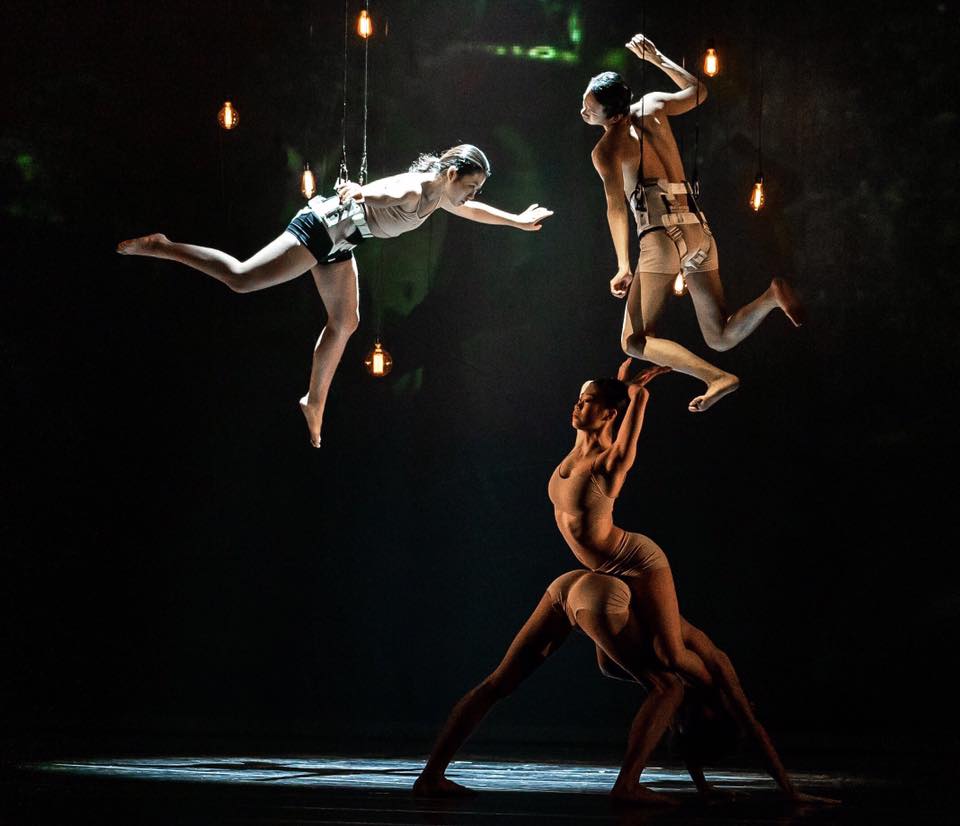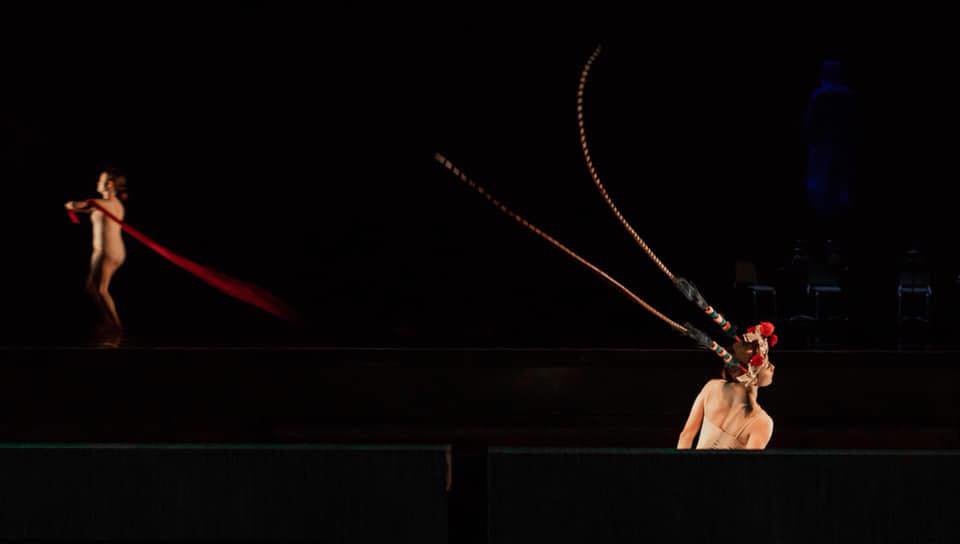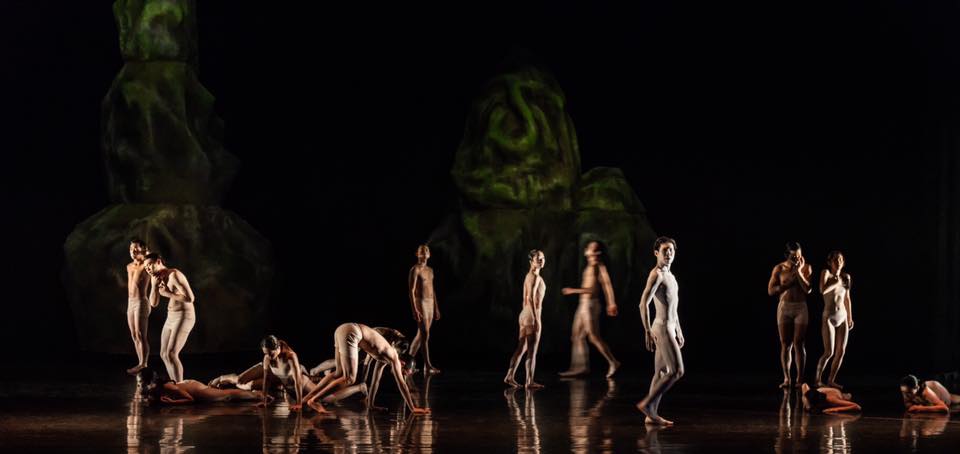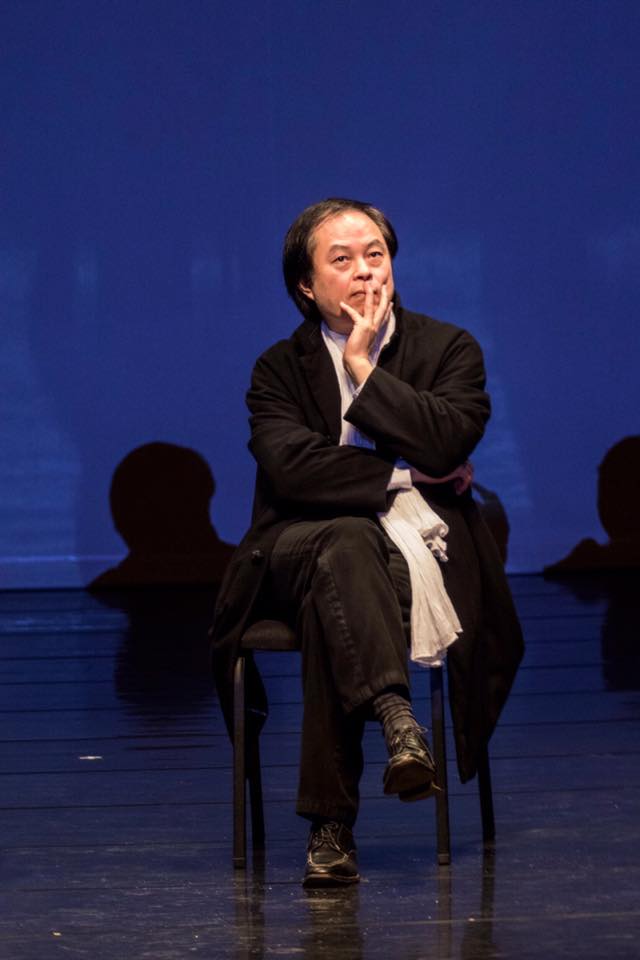Island Through Time
What’s our final destination in the long history of human civilization?
With a rumbling sound, the world was created. The people representing the primitive natives (wearing dance clothes in nude color) started dancing frantically. They were facing an unknown anxiety collectively. With a loud thunder, a naked man (played by Tan Tian) with white paint all over his body, without identity and with a slight hint of depression and stiffness on his face. He walked slowly in the valley. In this show, “White” represented an unnatural and abnormal symbol. Aside from his identity as a robot, everyone else had a thick white patch on their mouths and cheeks. The digital, cracked white faces turned into skulls, white giants with 3D floating shadows and purely white robotic arms. There were shadows of the five white monsters, and all the “whiteness” appeared in the medium of “reconstruction”.
Therefore, when “he” first opened his hands and looked up at the distant interstellar, it seemed to foretell that in the chaotic universe with mountains and forests, only “he” had witnessed the origin of the world. Who is “he” then? There is no answer in the drama. However, the “white” artificial medium provided the audience with a contextualized interpretation.
“He” walked slowly from the right side of the stage to the left many times during the play. At the same time, the events on the stage also altered accordingly, or the next technological innovation was initiated. As the content of the play follows the development of human technology (such as light, electricity, virtual projection, digitization, 3D perspective images, delaying technology of sound amplification, robotic arms, laser light, body temperature dynamic light spots, etc.). This man’s eyes were getting more and more determined. When he was looking at the audience, he wanted to show his evolution. Based on his performance, the author interprets from the presentation of the content, and he understands that “he” might be representing the optimization with technological assistance in the contemporary era. (1)
Through the eyes of another person, such an identification with contemporary technology to create a utopian world highlights the director’s attention to the value and impact of contemporary technology on the existence of human beings. In addition to the narration of the evolution of human civilization, “Island Through Time” is mainly concerned with social issues arising from industrial technology, and all artistic participation is to present this concept, continuing the subject consciousness in different sections.

The author observes that “Island Through Time” has created a sense of visual and auditory “overflow” through simplified body postures, slow movement, occasional body bursts, multiple artistic media and industrial technology. From the angle of the content of the performance, the show has reflected many issues co-existing in the contemporary world and they’re worth our reflection. The following is an analysis and discussion of the performance according to the order of different sections:
1. Race and power: In the play, the heads of races from all countries of the world are projected on the big screen, several heads of different skin colors and genders are captured at the same time. There was a 360-degree theater, and it finally gathered different collages and overlays. This method of presentation is like a rehearsal of a cut scene in which various ethnic groups are ruled, added by the simultaneous broadcasting of different languages of various countries. It formed an opposing world dominated by power and oppression. Immediately after that, on the walls on the left and right sides of the stage, there was an oriental face embedded like a condensed picture. He had only his eyes left to convey his personal will. In the end, even his eyes were frozen. His face, after processed by digital technology, was broken, collapsed and died. Finally, only a black skull remained. The modernization process here describes the disintegration of a human body. The struggle between races and power in the past seems to have to be put aside for the fragile body.
2. Cross-cultural aspect: On the stage, four violinists were playing repertoires with the unique voice on the musical color, at the same time accompanied by a huge white floating shadow (the man was wearing a cap and a long cape commonly seen in the West) walking around the stage in large steps. Comparing to the pipa solo in the auditorium with three dancers striving to show their culture under the stage (the three dancers, wearing red sleeves and headdresses of the Chinese opera female roles, who symbolized the oriental culture, jumped up with the help of simple box springs). The abovementioned made use of the upper and lower positions of the stage to highlight the contrast between the realistic and the virtual aspects of the oriental and western cultures, which have created contradictions and conflicts between the western powers (huge dominance) and the weakened oriental culture (struggling with external forces). It also reflects the new setting with the cross-cultural conflict. In addition, at the entrance of the stage, a dancer was wearing a red silk of the original culture, and danced. She was crossing the stage rapidly, and when she made a slight sound of the opera song, the red silk on her body was bounced back to her body, and it was initially stretched to a straight line. As her path represented the cultural line between the east and the west, it was a subtle reminder of the disappearance of the original culture.

3. Copy and replace: the white robotic arm in the front emitted laser light and swang towards the audience, and at the back, there was a robotic arm dancing a white long fluttering fan commonly seen in Chinese dances, with colorful neon lights emitting from above, and the three-dimensional limbs represented the naked dancers struggling outward. The dancer was controlled by a red silk by an outsider. Finally, the outsider threw the red silk and the other three fled. The above scene not only highlights the functionalization of the robotic arm, but it also tells us the helplessness of human beings. And when there was only one outsider dancing with the robotic arm in front of the stage (when the LED light danced with the robotic arm, the electronic induction was turned on instantly), audience could then observe the intimate interaction between the two, a kind of mutual trust was created. The scene stated more clearly that human innovation of AI (Artificial Intelligence) has replaced the new value of original humans. Secondly, following the dance of the robotic arm (which had fully demonstrated the attitude of the real performer), six humans kneeling on the mobile workbench appeared in the back, and they began to imitate the movements of robotic arm in the front. They sometimes had the same movement while at times different, just like a human losing himself and becoming a robotic cloned man. When one of the cloned men fell from stage, and when he kept twisting and turning in pain, it symbolized his pain inside. Then, several outsiders (with LED lights) pushed several store carts, huge tires and transmission belt with white light in, and took away the cloned man on the workbench.
4. Self-identification and survival disintegration: the man in white reappeared. At this time, an inverted cross-shaped stage appeared, which seemed to symbolize the crucifixion of Jesus Christ. A dancer was wearing a large white round skirt and kept spinning on the stage. Below the stage, there were five dancers rotating in the same place. There was also a half-step staircase in front of the left stage, on which stood a naked goddess in agony, her limbs kept trembling and she was staring at a long distance away. At the same time, the theater raised the questions, “Who am I? Me? Where did you come from?” to show the main idea of the theme. This kind of arrangement seemed to be the question that the man in white was asking himself and the anxiety that the naked woman was having to herself. After that, the central screen fell on the stage, and only the naked woman remained there. A man in ordinary clothes carried the naked woman back down the stairs to the center of the stage and helped her to put on her coat. After the screen was raised in the back, there was a fierce nine-pair duet dance expressing human interdependence and struggles. The characters were wearing shirts and khakis that symbolized work clothes. Dancers moved with large joints, they were pushing, squeezing, leaning or climbing. When they took off their outer clothes (meaning removing the symbol of socialization) and left their partners, a male dancer stared at the crowd, and the other naked dancers lost their minds and crawled on the floor like wild beasts. The only upright man showed fear on his face, then everyone fell from the stage to the orchestra pool one by one. This scene of suicidal acts shocked the viewers. Does it allude to the destruction of human beings who have lost themselves?

5. An utopian myth: in this section, a beautiful and pure world was created, with forests (projection), beasts (a man and a woman overlapped to create this scene), Adam and Eve (a steel wire descending from above), and a yellow light bulb, imitating the starry sky. All the installations present an unrealistic, dreamy and harmonious utopia. The man in white walked slowly toward the center of the stage, while the sky curtain projected the white outlines of five animals (white horse, white deer, white leopard, white bear and white tiger) in sequence, then the play ended. Such an outcome gave the rise of even more unsolvable questions, such as where humanity will end up in.
The content of the performance shown in “Island Through Time” is thought-provoking, and it is indeed difficult to get affirmative answers. The author believes that the director conducted a summary, a fragmentary presentation and recording of social phenomena from a brief history of human civilization, and focused on the presentation of topical phenomena, replacing the habit of pre-determined conclusions in classical dramas. As the audience, they could appreciate this performance in the form of curatorial exhibitions in contemporary art museums. For the huge issues and possible problems presented in the play, they’re still occurring in reality, and some are even unsolvable. This kind of presentation of unsolvable issues quite in line with the contemporary approach of “post theatre” (post theatre), that is, to create a position that cannot be preset through multimedia real-time touch technology. It does not rely on established texts, and may generate diverse symbolic information, allowing the audience to interpret it according to their personal experience, so that the work can have different meanings.
“Island Through Time” takes “art as a whole, refuse to classify” (2) as the appeal of its performance form, and to “de-text” (3), multiple art forms (multimedia, industrial technology, dance, Chinese and Western music, stage installations, etc.) to flatten (decentralized) and disperse (defocus) integrated performances. Also, with the subject consciousness involving a wide range of global social issues, the audience got to obtain considerable visual and auditory stimulation in just one hour. The author believes that “Island Through Time” fully demonstrates the artistic creation of art integration of multiple domains and contemporary high technology, it attempts to create a new form of performance. Such a cross-domain integration with high density and presentation of social issues are rare in Taiwan.

Shih, Chih-ru
Photography: Liu, Wei-Tsan
Footnotes:
(1) In the book "Post-human Era", Hayles used science fiction films, literary works, electronic technology and mechanic people as empirical and conceptual cases to propose that we have indeed moved towards the technological era created by human beings. And such an era has imposed an influence on our imagination and survival in the interpretation of the world. “Post-human Era” refers to the era in which life is extended by the support of medical technology or by wearing mechanical kinetic energy. In this era, human beings no longer rely solely on organisms. AI kinetic energy is also extended to the flesh and it expands the ability of organisms.
(2) It comes from the cover of the program. The form of performance of “Island Through Time” is "art as a whole, refuse to classify, Chen Chih-Cheng’s latest cross-border work". When looking at the term "art as a whole", it appeared in Wagner's (WR Wagner, 1813-1883) articles in 1849, in two articles called “Art and Revolution” and “The Artwork of the Future”. Gesamtkunstwerk (total artwork) is used to describe a form of cross-domain performance, different from the past collaborative performances mainly in collages. "Art as a whole" refers to the application of multiple art forms to fully display the main body of the work.
(3) According to the discussion after the performance on the 15th of December, director Chen Chih-Cheng mentioned that the play was a “de-texted” creation.


